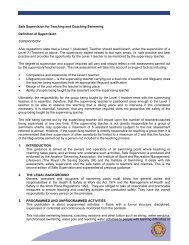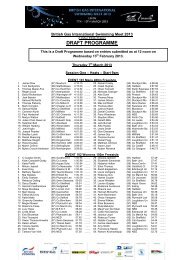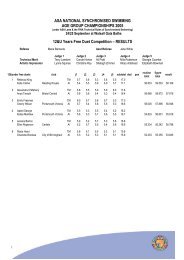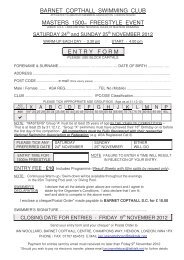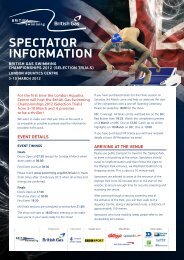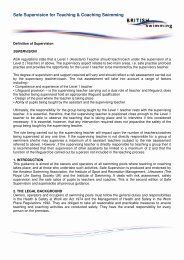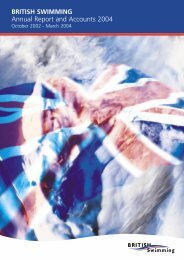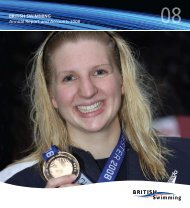Inclusion of Swimmers with a Disability - Swimming.Org
Inclusion of Swimmers with a Disability - Swimming.Org
Inclusion of Swimmers with a Disability - Swimming.Org
You also want an ePaper? Increase the reach of your titles
YUMPU automatically turns print PDFs into web optimized ePapers that Google loves.
Multiple Sclerosis<br />
This is due to damage to the myelin<br />
sheaf. When the myelin is damaged<br />
there is interference <strong>with</strong> messages<br />
between the brain and other parts <strong>of</strong><br />
the body.<br />
l Swimmer’s co-ordination may be<br />
affected.<br />
l <strong>Swimmers</strong> will have good and bad<br />
days.<br />
l Early achievement is essential to aid<br />
longer term mobility.<br />
l <strong>Swimmers</strong> may tire easily.<br />
Muscular Dystrophy<br />
This is congenital from birth condition<br />
although it is not obvious until later. It<br />
is a progressive degenerative disease <strong>of</strong><br />
muscles.<br />
l <strong>Swimming</strong> helps to keep muscles as<br />
fit as possible.<br />
l <strong>Swimmers</strong> have good and bad days.<br />
l Activities should be adapted<br />
accordingly.<br />
l As much as possible should be<br />
taught in the early stages.<br />
Osteo-genesis Imperfecta (Brittle<br />
bones)<br />
This is due to a congenital condition<br />
from birth.<br />
l Bones may break easily.<br />
l Medical limitations may be set.<br />
l Care is needed to avoid contact <strong>with</strong><br />
the poolside and other swimmers.<br />
Spina Bifida and spinal injuries<br />
resulting in paraplegia/tetraplegia<br />
This is due to a lesion or injury to the<br />
spine. The point <strong>of</strong> the lesion/break on<br />
the spine will determine the degree <strong>of</strong><br />
paralysis.<br />
l Many may have total sensory and<br />
motor loss below the site <strong>of</strong> the<br />
lesion.**<br />
l Care must be taken <strong>of</strong> paralysed limbs<br />
so that they do not get trapped or<br />
trail on abrasive surfaces when lifted<br />
or handled.<br />
l The swimmer may not notice wounds<br />
that take a long time to heal.<br />
l The swimmer may be incontinent but<br />
this is no barrier to swimming.**<br />
** Consideration should be given to<br />
discreet changing facilities.<br />
Strokes<br />
This is due to bleeding into the brain<br />
and <strong>of</strong>ten causes a degree <strong>of</strong> paralysis,<br />
usually to one side <strong>of</strong> the body.<br />
l Rehabilitation may bring back some<br />
movement especially when new<br />
balance has been achieved.<br />
l Speech is <strong>of</strong>ten affected,<br />
understanding is not.<br />
l Frustration is displayed <strong>of</strong>ten because<br />
<strong>of</strong> limitations in communication.<br />
Sensory impairments<br />
Visual<br />
This can range from total loss (blind) to<br />
individuals who remove their glasses and<br />
cannot see clearly.<br />
Hearing<br />
This can range from totally deaf to loss<br />
<strong>of</strong> hearing in a crowded environment,<br />
loss <strong>of</strong> pitch and to those who cannot<br />
hear when they remove their aids.<br />
Learning Disabilities<br />
This is due to a congenital condition or<br />
as the result <strong>of</strong> infection, injury, poison<br />
or nutrition.<br />
Other swimmers, who do not fit the<br />
descriptor above, may have learning and<br />
/or co-ordination difficulties that could<br />
affect learning to swim. Some examples<br />
are:- ADHD, Down’s Syndrome, Fragile<br />
X Syndrome, Aspergers, Dyslexia,<br />
Dyspraxia and Autism.<br />
Hidden conditions<br />
Asthma<br />
A condition that affects the airways to<br />
the lungs. The swimmer may require<br />
prescribed medication prior to or during<br />
exercise. If an attack occurs during the<br />
session sit the pupil out and call for<br />
appropriate assistance.<br />
Epilepsy<br />
A tendency to have recurrent<br />
seizures (sometimes called fits). If a<br />
seizure occurs during the swimming<br />
session, recover/rescue the swimmer<br />
appropriately. Each swimmer requires<br />
a knowledgeable spotter on poolside<br />
at all sessions.<br />
Cystic Fibrosis<br />
An inherent condition where mucous is<br />
formed causing respiratory difficulties.<br />
Tissues and bowl may be required on<br />
poolside.<br />
Heart conditions<br />
A condition where the heart is<br />
damaged.<br />
l A medical certificate is advised.<br />
l Do not over tire, most people know<br />
their own limitations.<br />
Diabetes<br />
A condition where the body produces<br />
little or no insulin.<br />
l Some swimmers may require special<br />
dietary requirements before or after<br />
the session as recommended by their<br />
doctor.<br />
Haemophilia<br />
A generic condition where the blood<br />
fails to clot easily.<br />
l More appropriate to swim in the<br />
prone position when learning to<br />
swim in order to prevent knocking<br />
into obstacles.<br />
Further information on these and<br />
other conditions can be found in the<br />
Caf Directory www.cafamily.org.uk<br />
or from local support groups.<br />
For further information on <strong>Disability</strong><br />
Specific Sports <strong>Org</strong>anisations please<br />
refer to page 24.<br />
6



